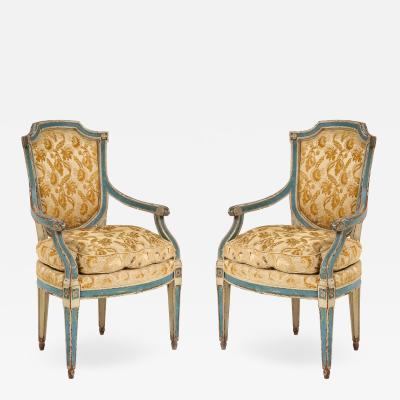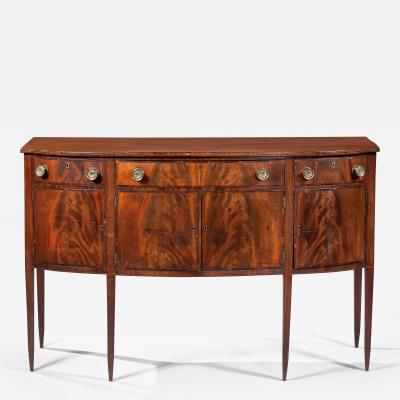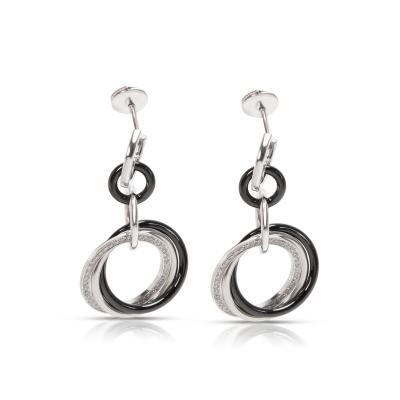Winterthur Primer Designing History at Winterthur and the White House
 |
by Kim Collison
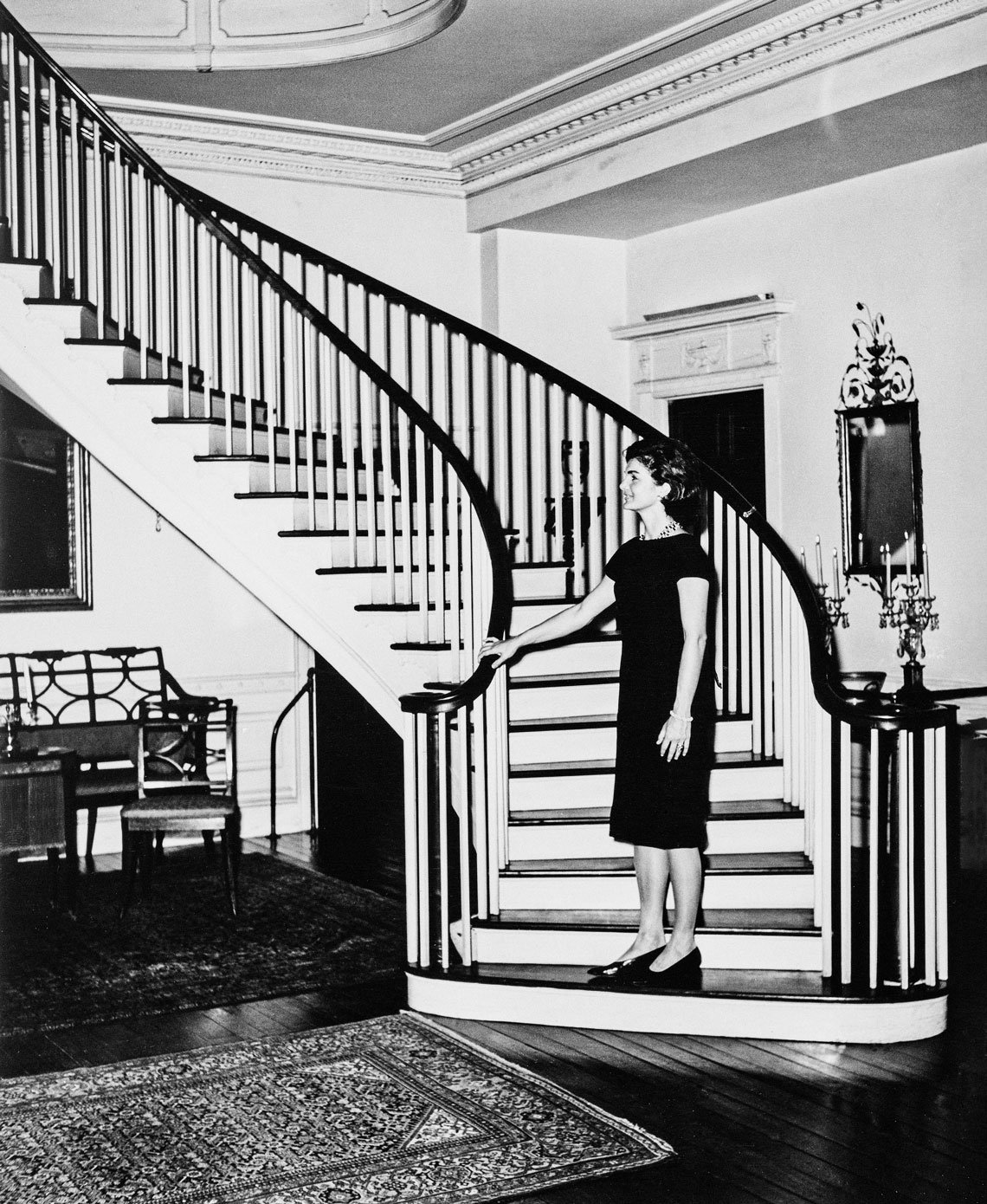 | |
Fig. 1: First Lady Jacqueline Kennedy was photographed on the Montmorenci stairs at Winterthur when she visited on May 8, 1961. Robert Hunt Whitten, photographer; Action Photo. Courtesy, the Winterthur Library: Winterthur Archives. |
In February of 1961, First Lady Jacqueline Kennedy invited Winterthur Museum founder Henry Francis du Pont to act as the chairman of her Fine Arts Committee, a group that would help guide her project to restore the White House. On May 8, 1961, Mrs. Kennedy visited du Pont at Winterthur where he and senior curator John Sweeney introduced her to Winterthur’s collection and interiors (Fig. 1). In a letter dated May 9, Mrs. Kennedy wrote to Mr. and Mrs. du Pont to thank them for her visit: “All I can say is I will never recover from it—or forget one tiny detail. I just can’t believe that it was possible for anyone to ever do such a thing. Mr. du Pont you now have me in such a state of awe and reverence I may never be able to write you a letter again!” 1
Despite this sentiment, the young first lady and du Pont exchanged many letters over the course of the next several years as they worked together to restore and furnish the White House with objects of historic significance. Mrs. Kennedy, whose visit to the White House as a child had left her with a far less favorable impression of it than the one she had of Winterthur, said, “It would be a sacrilege merely to ‘redecorate’ it—a word I hate. It must be restored—and that has nothing to do with decoration. That is a question of scholarship.” 2
 |
Fig. 2: The Baltimore Drawing Room at Winterthur features Federal period furniture and one of the many shades of green paint used in the Winterthur house. Winterthur Museum, Garden & Library. Photo by James Schneck. |
 |
Fig. 3: First Lady Jacqueline Kennedy admires objects on a Federal period sideboard in the Du Pont Dining Room at Winterthur. A set of six tankards made by Paul Revere, Jr. exemplify the type of important historic objects she hoped to acquire for the White House collection. May 8, 1961. Robert Hunt Whitten, photographer; Action Photo. Courtesy, the Winterthur Library: Winterthur Archives. |
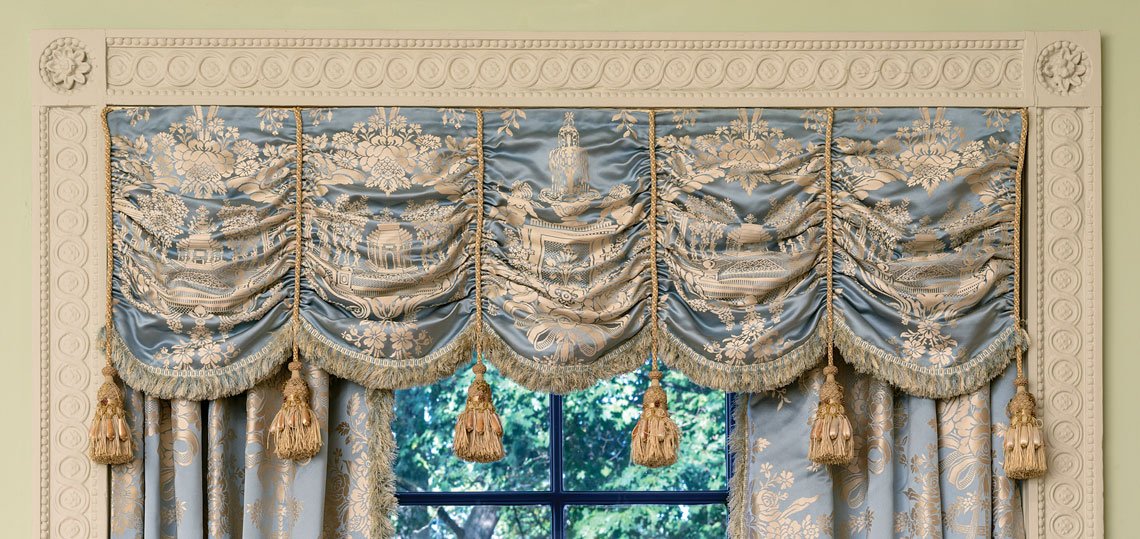 |
Fig. 4: Window hanging in the Baltimore Drawing Room at Winterthur are installed inside the woodwork according to Henry Francis du Pont’s preference. He insisted on this treatment for the curtains in the Green Room in the White House. Winterthur Museum, Garden & Library. Photos by James Schneck. |
 | |
| Fig. 5: Window hanging in the Baltimore Drawing Room at Winterthur are installed inside the woodwork according to Henry Francis du Pont’s preference. He insisted on this treatment for the curtains in the Green Room in the White House. Winterthur Museum, Garden & Library. Photos by James Schneck. |
Winterthur became the source of much of this scholarship. Du Pont as well as Winterthur Museum director Charles Montgomery and curator John Sweeney brought their expertise to the project and made introductions to curators, collectors, and historians from museums and collections around the country. The Winterthur Program in Early American Culture that du Pont had established with the University of Delaware in 1952, the year after the museum opened, was the first graduate program that focused on American decorative arts. In 1962, Lorraine Waxman Pearce, a graduate of the Winterthur program, became the first White House curator.
But Winterthur also served as design inspiration for Mrs. Kennedy’s project. At Winterthur, in rooms like the Baltimore Drawing Room (Fig. 2) and the Du Pont Dining Room (Fig. 3), Mrs. Kennedy saw how du Pont had created beautiful and inviting interiors for entertaining that also documented American history.
To bring similar history to the White House rooms, Du Pont assisted the First Lady in acquiring objects that documented the nation’s history and the house’s former occupants. The two also corresponded about design choices, including colors, fabrics, and appropriate styles. Du Pont’s design aesthetic and direction was most evident in the Green Room in the Kennedy White House. While du Pont claimed green was “one of the prettiest colors there is,” the color of the Green Room was not his choosing and had been established in the 19th century.3 In 1961, the room featured a green silk damask wallcovering with matching window hangings that had been installed during the Truman era. Du Pont’s preference for curtains to be placed inside the window casings so the woodwork would be visible resulted in a plan to re-work the Truman-era curtains in this style, much like the curtains in Winterthur’s Baltimore Drawing Room (Figs. 4, 5, and 6).
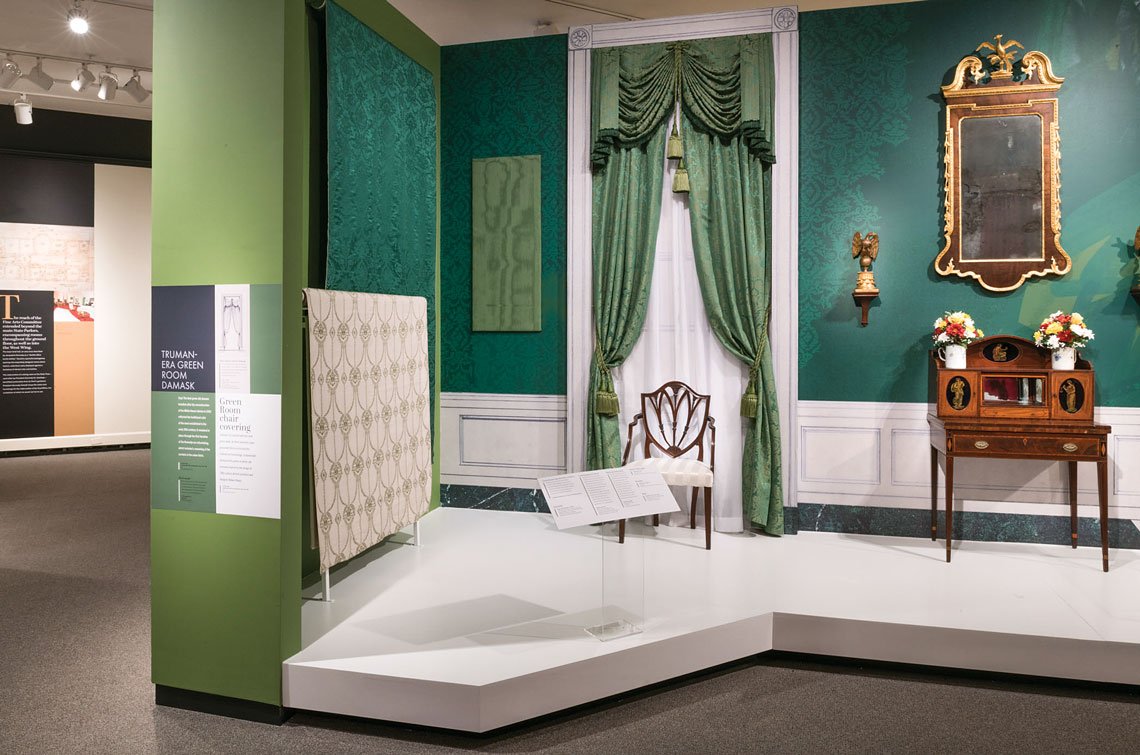 |
Fig. 6: Reproduction curtains created by Natalie Larson of Historic Textile Reproductions for Winterthur’s exhibition Jacqueline Kennedy and H. F. du Pont: From Winterthur to the White House exemplify du Pont’s preference for curtains to be installed inside the woodwork. Photo by James Schneck. |
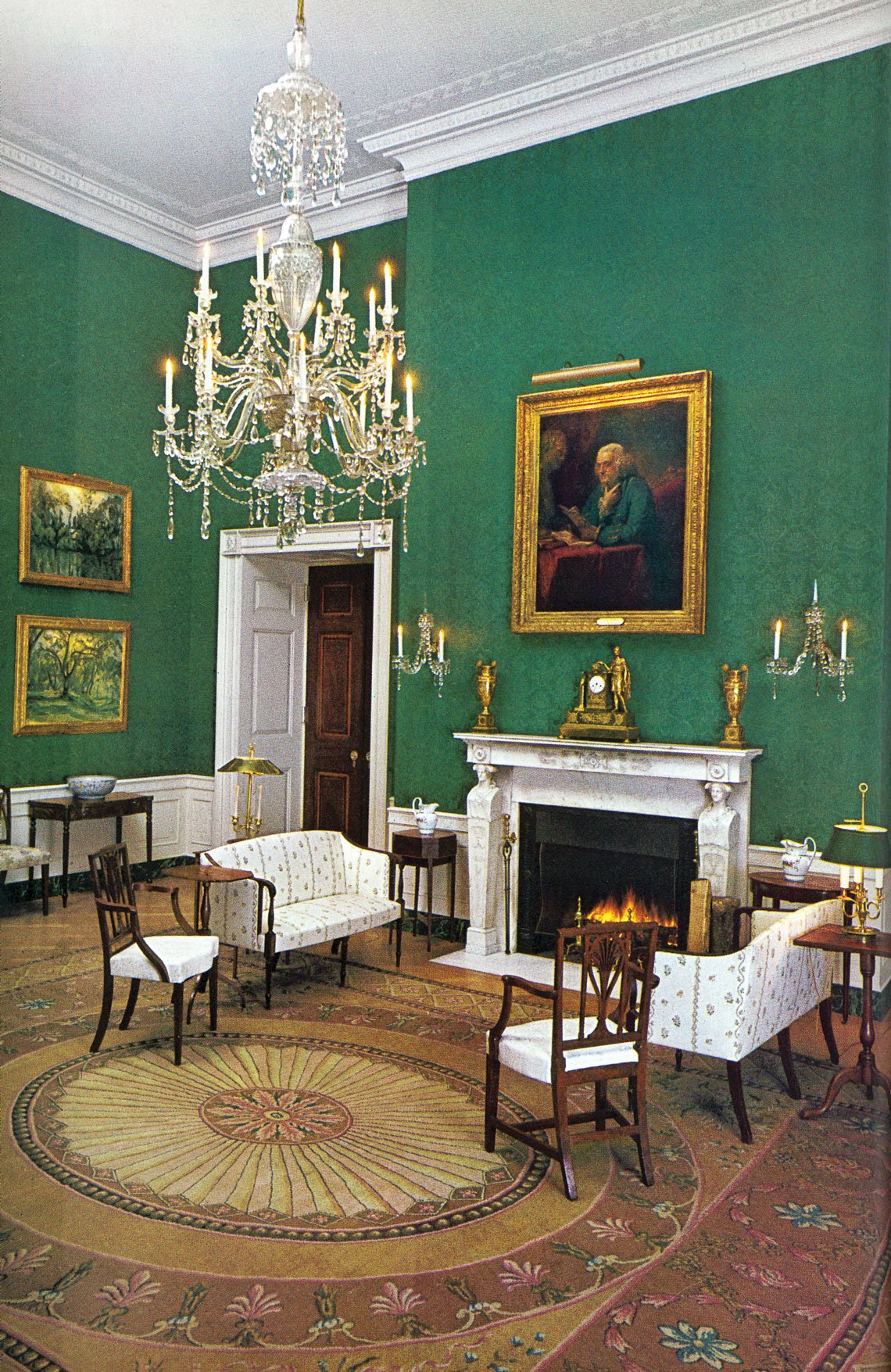 | |
Fig. 7: The Green Room of the White House (ca. 1962) featured two card tables (one shown here left of the door) donated by du Pont’s sister Louise du Pont Crowninshield during the Truman administration. Du Pont selected other Federal period furniture to go with these pieces and covered them in cream grounded fabrics to contrast with the dark green walls. White House Historical Association |
The Federal period furnishings du Pont chose for the Green Room (Fig. 7) were also similar to those used in his Baltimore Drawing Room. The Winterthur room features fine examples of Sheraton and Hepplewhite-style furniture with straight, tapered legs, clearly defined geometric forms, and delicate inlay. Du Pont strongly preferred this style over the French-inspired Empire style used in the Blue and Red Rooms, but this direction for the Green Room resulted in part from a pair of card tables that he noticed in the room when he first visited during the Kennedy administration. As Mrs. Kennedy shared in her February 1962 A Tour of the White House with Mrs. John F. Kennedy, she and du Pont later discovered that du Pont’s sister, Louise du Pont Crowninshield, had donated these tables to the White House during the Truman administration when she had served as an advisor on his committee to redecorate the residence.4 With inspiration from these tables, du Pont set about furnishing the Green Room with objects like those he had carefully selected for some of his own rooms at Winterthur.
Visitors to Winterthur Museum, Garden and Library today can take the “Walk in Jackie’s Footsteps” tour of the house to see how the Baltimore Drawing Room and other Winterthur rooms inspired the White House interiors. In the galleries, the exhibition Jacqueline Kennedy and H. F. du Pont: From Winterthur to the White House, on view through January 8, 2023, provides an in-depth look at the partnership between Mrs. Kennedy and Mr. du Pont. Curated by Elaine Rice Bachmann, co-author with James Archer Abbott of Designing Camelot: The Kennedy White House Restoration and Its Legacy, the exhibition explores this transformative design project that brought together important designers and scholars of the twentieth century.5
 |
1. Letter from Jacqueline Kennedy May 9, 1961, Winterthur Archives.
2. Hugh Sidey, “The First Lady Brings History and Beauty to the White House,” LIFE Magazine, September 1, 1961.
3. Oral history with Harlan B. Phillips, April 11, 1962.
4. A Tour of the White House with Mrs. John F. Kennedy aired on CBS and NBC on February 14, 1962, and then on ABC on February 18, 1962, and reached an audience of an estimated 80 million viewers.
5. For more information on the Kennedy-era restoration of the White House, see James Archer Abbott and Elaine Rice Bachmann, Designing Camelot: The Kennedy White House Restoration and Its Legacy (Washington, DC: White House Historical Association, 2021).
Kim Collison is Curator of Exhibitions at Winterthur Museum, Garden & Library.















